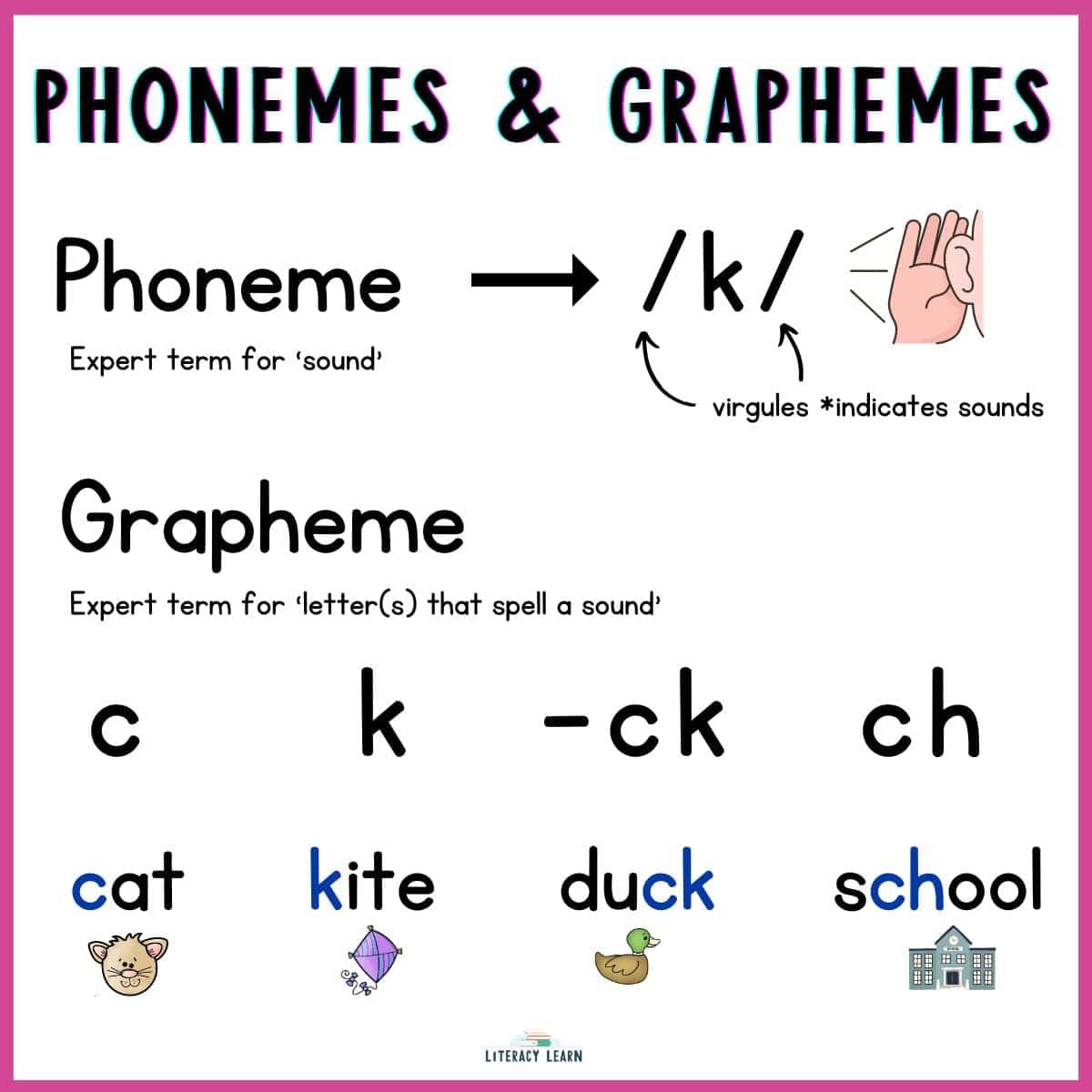Phonemic Awareness Practice with Letters
This post may contain affiliate links. As an Amazon affiliate, we earn from qualifying purchases. See our disclosure policy.
Learn all about what phonemic awareness is, the skills included within phonemic awareness, and why it’s best to practice phonemic awareness with letters. Read the research and get activities to use in your classroom with students.

👂🏼What Is Phonemic Awareness?
Phonemic awareness is the awareness of the sound units that make up spoken words.
These smallest sound units are called phonemes.
/p/ is a phoneme (not the letter p, but the sound.) Phonemes are usually indicated as “sounds” between two slashes / / called “virgules.”
You try it! What phonemes are represented below? Tip: Make the sound out loud!
- /h/
- /l/
- /k/
- /sh/
- /tch/

🎧 More about phonemes: As seen in the graphic above, many times a phoneme can be represented by multiple graphemes.
The /k/ sound can be represented by different graphemes such as the letters and letter combinations c, k, -ck, and even ch. This is why spelling can be so tricky!
What’s Included in Phonemic Awareness?
There are various subsets within phonemic awareness. Below the skills are listed in order of easiest to most difficult.

- Phoneme Isolation is the ability to identify and manipulate individual sounds within spoken words.
Teacher: “What sound do you hear at the beginning of the word ‘pit’? Student: /p/. - Phoneme Blending is the skill of combining individual sounds together to form a complete word.
Teacher: “What word am I saying? /p/ /i/ /t/” Student: “pit” - Phoneme Segmenting involves breaking down a word into its individual sounds or phonemes.
Teacher: “Tell me the sounds you hear in the word “pit?” Student: “/p/ /i/ /t/” - Phoneme Addition is the process of adding a new sound to an existing word to create a new word.
Teacher: “If the word is “pit” and I add /s/ to the beginning, what is the new word?” Student: “spit” - Phoneme Deletion is the act of removing a sound from a word to create a new word.
Teacher: “If the word is “pit” and I delete the /p/, what is the new word?” Student: “it.” - Phoneme Substitution is the skill of replacing one sound in a word with another sound to create a new word.
Teacher: “If the word is “pit” and I switch the /i/ for /a/, what is the new word? Student: “pat.”
More About Phonemic Awareness
Phonemic awareness is a skill that falls under the larger category of phonological awareness.
According to the National Reading Panel (2020), phonemic awareness is the first pillar of literacy, and it is foundational for reading success.
Phonemic awareness is the most important of all phonological awareness skills because without it, kids will struggle with reading and spelling tasks.
🤔 Think about this! If a child struggles with blending tasks, reading words accurately will be VERY difficult.
And if students struggle with segmenting tasks, their spelling will include many errors. Phonemic awareness is an essential foundation for skilled readers!
Phonemic Awareness with Letters
Research has indicated that phonemic awareness is MOST effective if paired with letters.
This is supported by the National Reading Panel (2020) when they stated: “Teaching children to manipulate phonemes with letters exerted a much larger impact on spelling than teaching children without letters” (2-4).
A more recent meta-analysis (2024) affirms that students benefit from a limited number of auditory only drills, with the average being about 10 hours. After that, most students continue to make progress with these skills when connected with letters.
Incorporating letters with phonemic awareness instruction builds students’ knowledge of the alphabetic principle.
Using letters allows students to clearly see the connection between spoken sounds and written letters. Adding letters takes it from auditory only to multisensory (adding visual, and also kinesthetic if students write the letters).
Adding letters builds a meaningful bridge that connects phonemic awareness and phonics.

✨ Remember, students with dyslexia have deficits in the phonological processing part of their brain.
These students will need more focused and intentional practice to build up the connections and strengthen the pathways in their brain.
👉🏼 Learn about dyslexia therapy at Literacy Learn Reading Solutions.
Phonemic Awareness Activities
Now that you know the facts, we want to provide you with actual activities and ideas to help your students build the bridge between phonemic awareness and phonics skills.
Sound Boxes: Give students these blank sound boxes to manipulate phonemes. Laminate the sound boxes using dry-erase laminating sheets for extended use.
Use oral activities and then have kids match the sounds they hear with letters by writing each grapheme in the corresponding sound box.
Word Cards: Use these double-sided CVC word cards. Kids can first look at the picture, say the word, then practice isolating and segmenting the sounds.
Then they’ll flip them over to match the phonemes with graphemes to strengthen and build sound-symbol correspondences. These can also be used for blending practice, too!

Word Ladders: Word ladders are the perfect activity for adding, deleting, and substituting phonemes. Get our popular word ladder resource that includes 78 word lists organized by phonics skills.
Phoneme Manipulation: Grab our 3 FREE Phoneme Manipulation worksheets for practicing phoneme substitution. Pictures and letters included!
Blending Sounds: Using connected phonation is the research-backed way to engage students with blending. We’ve created the perfect resource with 32 no-prep worksheets for blending practice.
Sound Wall: Using a Sound Wall is a great tool used to make the sounds we hear within words connect to the letters that spell a sound.
It’s a visual representation showing the speech-to-print connection. Get our low-prep sound wall with real and diverse mouth articulation photos!
We also recommend David Kilpatrick’s book, “Equipped for Reading Success.” It includes one-minute daily drills intended to build students PA skills with quick, oral activities.

